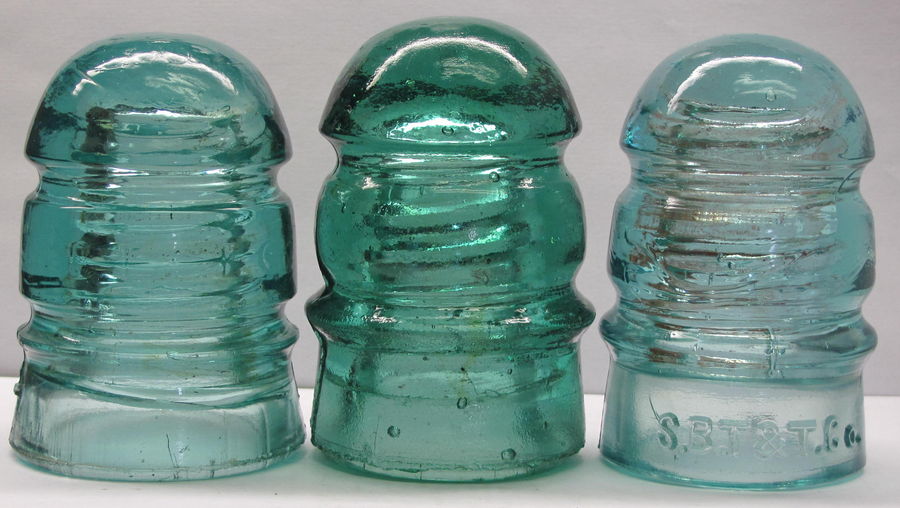CD-112 No Embossing Vs. Southern Bell Skirt & Center Embossed CD 112 - Georgia - Post 7
By Jack Kesling; posted October 6, 2020
View Original: Click to zoom, then click to magnify (3123 x 1764) 624KB

|
During the period from 1968 to 1972, I was not able to locate any "older" telephone lines which carried small "pony" style telephone insulators. In 1969 a friend that I worked with at Robins AFB, Georgia learned that I collected insulators. He was living with his parent on a farm North West of Cockran, Georgia. Apparently, Southern Bell started to replace /re-build their early telephone lines some time between the late 1950's and the early 1960's and had asked to use their farm woodlot to dump the insulators used on the local lines and the drops into the houses. I was invited to their farm to explore the 1,000's of insulators dumped in the pine woods on one end of their farm. When I got to the farm, I could not believe how lucky I was. I was looking at a pile of insulators that was about 20 feet long, 10 feet wide, and about two feet high containing 1,000's upon 1,000's of insulators. The pile contained the following CD numbers: 101, 102, 103, 106, 108, 112, 112.4, 115 and CD 1085. Most of the insulators were common and most had damage, but I was able to find many good additions to my collection. It took me five weekend days to go through the pile. My fifth post [id=606599032] shows the CD 112 No Embossing greenish-aqua (with a small amber streak) keg /exchange style insulator which was found in the pile. I found five of these insulators that were collectable. The unique feature is a internal skirt ring of very small drip point [id=606599513]. Until I took the digital picture for this post, I never noticed this feature. I'm thinking this is likely a Hemingray product which was made for Southern Bell. Post number seven shows a picture comparing the CD 112 No Embossing insulator with the the two CD 112 S.B.T.T. Co. skirt and center embossed insulators. Note the style and height difference between the three kegs. Also, I checked the two CD 112 S.B.T. & T. Co. insulators for internal drip point. The skirt embossed Southern Bell did not have the internal drip point; however, the center embossed S.B.T. &T. Co. had a rough internal edge that might act like drip points. Neither looked like the CD 112 No Embossing insulator. The following e-mail comment came from Paul Greaves Interesting photos and stories, I've enjoyed them all. Keep posting more if you have them! On this one I think the one on the left is Hemingray made, the middle is Pennycuick made and the right is Brookfield made. Note that the essential feature that identifies Pennycuicks is the method used when the threads were molded (which leaves very crisp sharp threads). They usually have that dot at the top of the pinhole, but sometimes they don't as well. The dot is caused by the lathe mechanism that holds the threading mandrel as the threads are cut. If the finished mandrel is then "cleaned up" by shaping or filing down the top to remove the dot (a dimple in the mandrel) then it will not appear in the finished product. I base the other associations from comparisons with other insulators known to be made by various manufacturers. As you noted, the center embossed SBT&T insulators are very similar to the Hemingray no. 8 in molding features and glass colors. The same can be said of the right hand skirt embossed SBT&T as compared to some Brookfield made CD 112s. Note that the Pennycuick style like your center insulator also comes embossed on the skirt with S.B.T.& T.Co., but otherwise looks just like your center insulator. Those seem to be hard to find and are apparently relatively scarce with the SBT&T name. Hope this helps! Note: Paul did some research and came up with the following "Pennycuick" CD 112 S.B.T. & T Co. ICON post [id=445541086] |